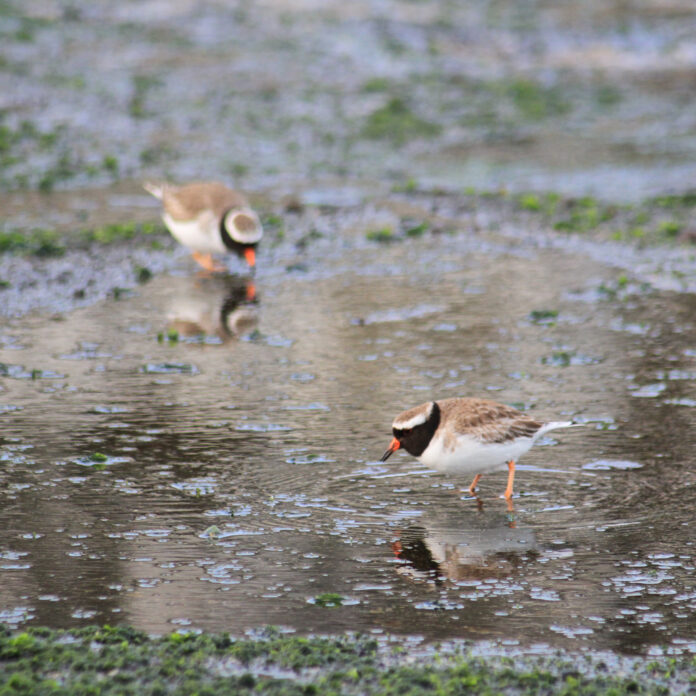Source: Department of Conservation
The shore plover is described as a bird in need of urgent PR. With just 250 individuals left in the wild on several predator-free islands, it is one of the world’s rarest shore birds, facing issues related to real estate, genetics and a pandemic. Through collaboration and cooperation with tangata whenua, tchakat henu, community groups, and other stakeholders, the DOC-led Shore Plover Recovery Programme aims to turn the tide on this bird’s fate. The bi-monthly, ‘Tūturuata Telegraph’ takes a closer look at what it takes to bring this unique species back fro the brink of extinction.
In 1873, in reference to reports that shore plover were rare, keen ornithologist Thomas Potts commented, “It is not unlikely that the idea of its reputed rarity has arisen rather from the lack of close observation than from the scarcity of the species.” Ironically, his accompanying observation of three pairs of shore plover at the mouth of the Waikawa River in Otago was the last on the New Zealand mainland.
Rangatira, The Pyramid and Pitt Island
” data-medium-file=”https://i0.wp.com/blog.doc.govt.nz/wp-content/uploads/2022/02/Rangatira-from-Pitt.jpg?fit=300%2C172&ssl=1″ data-large-file=”https://i0.wp.com/blog.doc.govt.nz/wp-content/uploads/2022/02/Rangatira-from-Pitt.jpg?fit=580%2C332&ssl=1″ loading=”lazy” width=”580″ height=”332″ src=”https://i0.wp.com/blog.doc.govt.nz/wp-content/uploads/2022/02/Rangatira-from-Pitt.jpg?resize=580%2C332&ssl=1″ alt=”” class=”wp-image-46350″ srcset=”https://i0.wp.com/blog.doc.govt.nz/wp-content/uploads/2022/02/Rangatira-from-Pitt.jpg?resize=1024%2C586&ssl=1 1024w, https://i0.wp.com/blog.doc.govt.nz/wp-content/uploads/2022/02/Rangatira-from-Pitt.jpg?resize=300%2C172&ssl=1 300w, https://i0.wp.com/blog.doc.govt.nz/wp-content/uploads/2022/02/Rangatira-from-Pitt.jpg?resize=768%2C440&ssl=1 768w, https://i0.wp.com/blog.doc.govt.nz/wp-content/uploads/2022/02/Rangatira-from-Pitt.jpg?resize=1536%2C880&ssl=1 1536w, https://i0.wp.com/blog.doc.govt.nz/wp-content/uploads/2022/02/Rangatira-from-Pitt.jpg?w=1886&ssl=1 1886w, https://i0.wp.com/blog.doc.govt.nz/wp-content/uploads/2022/02/Rangatira-from-Pitt.jpg?w=1160&ssl=1 1160w, https://i0.wp.com/blog.doc.govt.nz/wp-content/uploads/2022/02/Rangatira-from-Pitt.jpg?w=1740&ssl=1 1740w” sizes=”(max-width: 580px) 100vw, 580px” data-recalc-dims=”1″/>
For the next 120 years, shore plover or tūturuatu were only known to exist on South East (Rangatira) Island in Rēkohu / Chatham Islands, named for its orientation to the Chathams’ second largest motu, Pitt Island. It’s Moriori name Hokorereoro is more revealing of its nature, loosely meaning “the vibration of flight” in reference to the sight, sound and feeling of millions of petrels and shearwaters that call it home.
Rangatira Island is home to an incredible diversity of species reflective of the high level of endemism found in the Chathams (47 plants and fungi, 10 seaweeds, 16 birds, one lizard and more than 50 invertebrates). It is 219 ha in area, rising to 224 m above its western cliffs, flanked with rocky platforms and covered with thick scrubby forest. It is home to the majority of the black robin and Chatham snipe populations and provides for so many burrowing seabirds that DOC staff need to clomp around in a special sort-of snow-shoe to avoid destroying their homes. At night the forest floor is alive with seabirds and invertebrates including wētā and the large Rangatira spider. The reason for this incredible biodiversity is that despite being a whaling shore station in the 1800s and farmed for many decades, the island has remained miraculously free of all mammalian pests.
It is no surprise then, that here on the edge of the world, the shore plover, known as tchūriwat’ to Moriori, was able to cling to survival. Today, more than half the total population of 250 birds are found here.
Noted ornithologist Sir Charles Fleming visited Rangatira Island in 1937 and made important observations of shore plover breeding behaviour, ecology and population size. Impressed by the island’s abundant wildlife and lack of vermin, Fleming hoped that the island could one day become a sanctuary for the preservation of the characteristic flora and fauna.
This hope was realised in 1953 when the Crown purchased the island and removed the last sheep in 1961, establishing and managing it as a Nature Reserve. Despite virtually no forest remaining after its time as a farm, the island bounced back remarkably quickly and flourishes today with Chatham Islands ribbonwood, mahoe, akeake, harakeke, pohuehue, matipo and megaherbs. There is restricted access to the island in order to protect the last refuge of shore plover, the biggest population of critically endangered black robin, the Chatham petrel and several other species.
Recognising that a single population of shore plover on a small island was vulnerable to extinction, in the 1970s the then NZ Wildlife Service attempted the first translocation of the species to nearby Mangere (Maung’ Rē) Island. While unsuccessful, it spurred efforts to establish a captive-breeding population and develop release techniques.
Today, a captive breeding population of shore plover is held across three facilities on the New Zealand mainland, providing captive-bred juveniles for release onto pest-free islands. All the captive pairs derive from eggs collected from Rangatira Island that are transported by boat, plane and road to captive facilities. Although the captive population was founded in the 1990s, occasional transfers of eggs from Rangatira Island are required to maintain the genetic diversity of the captive and translocated populations; the most recent being in 2020.
Shore plover numbers on Rangatira Island are surveyed twice a year and chicks are fitted with metal bands to identify them. A number of the adult birds are also fitted with brightly-coloured plastic bands to allow them to be identified at a distance. These birds act as sentinels and are checked on every visit to the island – their absence could mean the arrival of an unwelcome predator.
Managing populations of endangered species on Rangatira Island is in a word, arduous. Before a visit, each piece of clothing is washed in Sterigene, a biocide which kills all bacteria, viruses and spores. Boots are scrubbed of mud. Tweezers are used to painstakingly combs seams, linings and pockets for any stray invaders. This is done to avoid any disease or pest species arriving on the island, which could be disastrous for these populations. Visits are 2–4-week stints and everything needed is brought in by boat. Patchy wi-fi is gained standing on top of an exposed rock. Despite its complexities, DOC staff and volunteers rave about their time on the island.
Without Rangatira Island and its remarkable pest-free history, shore plover would be just another of our many extinct species. Our ability to introduce captive-bred birds to pest-free islands, sourced from this wild population, is crucial to our aims to restore shore plover to parts of its former range and reduce the long-term risks of extinction.



